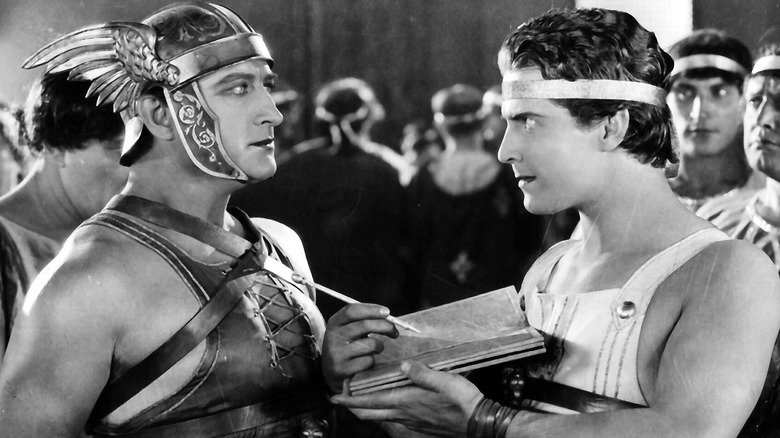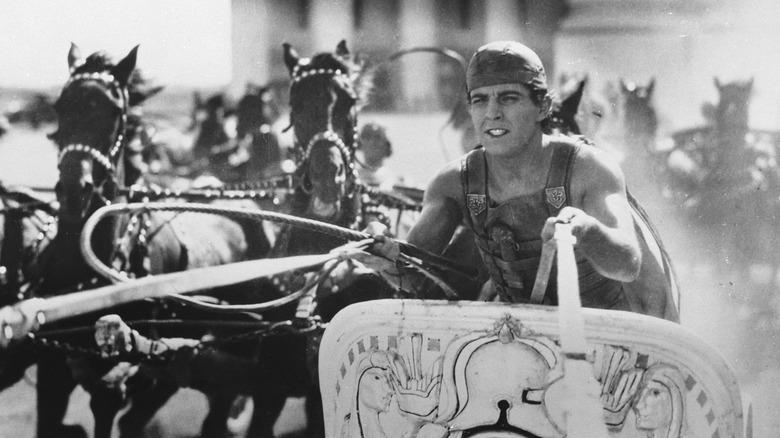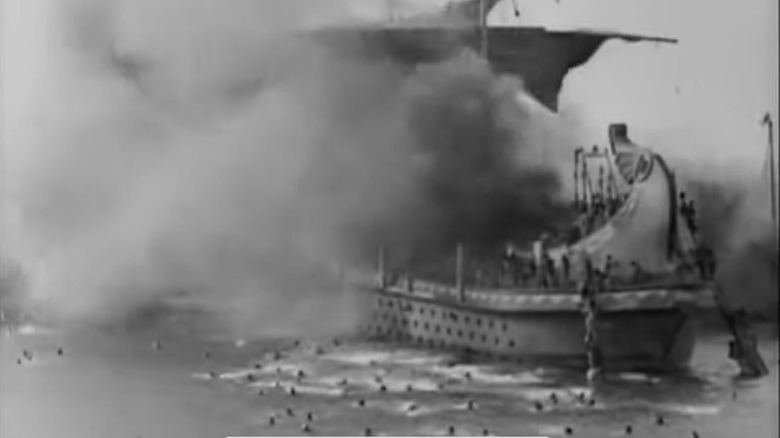The Original Ben-Hur Action Sequences Were More Dangerous Than You Think
A good stretch of Hollywood history saw the movie-making capital go full force on the religious epic, which almost always featured a spectacularly huge cast, budget and runtime. For every "King of Kings," there was a "Greatest Story Ever Told" right behind it. If one adaptation were produced in the silent era, a sprawling Technicolor remake would usually follow a few decades later ("The Ten Commandments"). Of course you can't speak about this specific period without addressing the mighty reign of "Ben-Hur" on the big screen.
General Lew Wallace's 1880 novel "Ben: Hur: A Tale of the Christ," a faith-based story of brothers turned enemies, is responsible for two of Hollywood's most epic productions. The 1925 epic ("Ben-Hur: A Tale of the Christ") stood supreme as the most expensive silent film ever made, resulting in a budget close to $4 million, while the 1959 film ("Ben-Hur") swept the Oscars with an unprecedented 11 wins – including Best Picture. There's also a $100 million remake that came out in 2016, and seems to have been forgotten about just as quickly as it came to theaters.
When talking about the various adaptations of "Ben-Hur," the 1959 William Wyler-directed epic, which starred Charlton Heston, is often the most celebrated, but the production history of Fred Niblo's 1925 production is too wild to ignore. Given recent events, the topic of set safety is one that we need to keep having. Careless oversight in regard to cast and crew safety has led to a string of productions going horribly wrong. In many cases, you can see how easily they could have been avoided. In order to see the steps that need to be taken, we need to look back at a notorious film shoot that probably should have condemned the project. Hold onto your chariots, folks.
Chariot collision course
If "Ben-Hur" were a Thanksgiving dinner, the chariot race sequence would be the centerpiece. Every adaptation knew this was the one thing to get right, and both productions more than delivered. In addition to acting as the film's premiere action sequence, this was also the emotional climax of the tragic rivalry formed between Judah Ben-Hur (Ramon Novarro) and Messala (Francis X. Bushman), where everything each has fought for is on the line. I can't help but find myself compelled by the sheer mastery on display with the chariot race in William Wyler's 1959 film, but the sequence featured in Niblo's "Ben-Hur: A Tale of the Christ" (1925) is a staggering achievement in and of itself. Spectacle was the name of the game. The form was continuing to find ways to make audiences believe in the power and scope of cinema.
The documentary "Ben-Hur: The Making of an Epic" recounts how the crew of the silent epic constructed their Colosseum in Culver City, California, with thousands of extras, and over 42 cameramen present to capture every angle of the exciting race. With that many cameras rolling at once, naturally, they caught the gasp-inducing accident that ended up in the film, and is still pretty shocking to watch. Even with all of the chaos going on within the homemade Colosseum, the producers had recklessly offered a $5,000 bonus incentive to the horse wranglers and rodeo stars, who played chariot drivers, that won the race.
Of course when you have that kind of money on the line, you could only imagine how fast each chariot was going. With one chariot left broken in the middle of the arena, you can see other drivers plowing into one another, causing a pileup that, according to a Snopes article detailing the production's troubles, may not have caused any human casualties, but unfortunately led to the death of five horses. Not even the film's assistant director, who can be seen far off in the background, couldn't warn the other chariot drivers to steer clear of the accident, resulting in pileup that remains in the movie. When you look further into what initially brought the troubled production to Culver City, that's when this story gets really upsetting.
When in Rome, recklessness follows
The silent era truly was the Wild West in regard to set restrictions and safety. A detailed piece from Grunge details how only three years after "Ben-Hur" (1925), the massive set piece of "Noah's Ark" involved flooding the set with over 600,000 gallons of water, which ultimately resulted in the death of three extras and countless injuries. I tell you this to prepare for the string of set irresponsibility that makes the chariot collision look tame in comparison. The "Ben-Hur" (1925) Culver City incident may not have turned fatal, but that doesn't mean that the production was without its share of fatal casualties.
A comprehensive piece from Yahoo News chronicles how these largely unsupervised shoots in Rome made for a production that sounds like an absolute nightmare:
"An elderly actor nearly caught pneumonia when forced to shoot on a raft in the Mediterranean Sea for three days. Fred Niblo got angry and threw stuff at child extras. Set construction had to wait because of political riots. The props were destroyed in a warehouse fire. And finally, crew members accidentally dug into an ancient Roman catacomb, destroying the site and enabling a free-for-all pillage of 2,000-year-old artifacts."
The catastrophes of "Ben-Hur" (1925) is like a Russian nesting doll, in which each one reveals another terrible facet of what it took to make this monumental spectacle. In that same piece, Bushman describes the fatal accident of a chariot driver, who drove on a set that was ill-equipped to handle the chariots, that eventually sent the production packing to California:
"During one take, we went around the curve and the wheel broke on the other fellow's chariot..." the hub hit the ground and the guy shot up in the air about 30 feet. ... It was like a slow-motion film. He fell on a pile of lumber and died of internal injuries."
Reckless abandon led to this terrible loss, and that's not even mentioning the death toll of these horses, which totaled to at least a hundred. In case that wasn't enough, apparently one of the Roman ships caught fire earlier than expected, which resulted in countless extras jumping overboard. Many of them couldn't swim, and there was no official record of the fate of three extras who allegedly went missing. You think it can't get any worse, but somehow "Ben-Hur" (1925) constantly defies the odds.
It's exactly the epic spectacle that MGM wanted, but at what cost? It's become so easy to consume art without thinking of the people behind it, or in this case, at the behest of it. The near-hundred year gap between "Ben-Hur" (1925) and the reports of current on-set deaths show how the motion picture industry has always been ill-equipped to handle the safety of their crew, so long as they get the shot they need.


